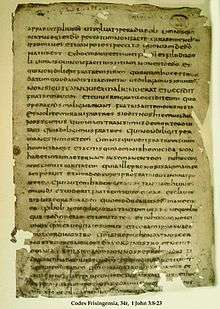Frisingensia Fragmenta

The Codex Frisingensis, designated by r and q or 64 (in Beuron system), is a 6th or 7th century Latin manuscript of the New Testament. The text, written on vellum, is a version of the old Latin. The manuscript contains the text of the Pauline epistles with numerous lacunae[1] on only 26 parchment leaves.[2]
The manuscript is variously dated. Vogels and Wordsworth dated it to the 5th or 6th century, Merk to the 7th century, Bover and Kilpatrick to the 7th or 8th century.
- Contents
Rom 14:10-15:13; 1 Cor 1:1-27; 1:28-3:5; 6:1-7:7; 15:1-1:43; 16:12-27; 2 Cor 1:1-2:10; 3:17-5:1; 7:10-8:12; 9:10-11:21; 12:14-13:10; Gal 2:5-4:3; 6:5-17; Eph 1:1-13; 1:16-2:16; 6:24; Phil 1:1-20; 1 Tim 1:12-2:15; 5:18-6:13; Hbr 6:6-7:5; 7:8-8:1; 9:27-11:7.[3]
1 John 3:8 - 5:9.
Text
The Latin text of the codex is a representative of the Western text-type in the itala recension.[3]
In 1 Corinthians 2:4 it supports reading πειθοις σοφιας λογοις (plausible words of wisdom) – (א λογος) B (Dgr 33 πιθοις) Dc 181 1739 1877 1881 vgww eth.[4]
It contains the Comma Johanneum.[5]
History
Eight leaves were examined by Tischendorf in 1856.[1][3] It was examined by Henry J. White, Wordsworth, Donatien de Bruyne, Leo Ziegler, and A. Jülicher.
Currently it is housed at the Bayerische Staatsbibliothek (Clm 6436) in Munich.[2]
See also
References
- 1 2 Scrivener, Frederick Henry Ambrose; Miller, Edward (1894). A Plain Introduction to the Criticism of the New Testament. 2 (4 ed.). London: George Bell & Sons. p. 53.
- 1 2 Bruce M. Metzger, The Early Versions of the New Testament, Oxford University Press, 1977, p. 305.
- 1 2 3 Gregory, Caspar René (1902). Textkritik des Neuen Testaments. 2. Leipzig: Hinrichs. p. 612. ISBN 1-4021-6347-9.
- ↑ UBS3, p. 581.
- ↑ UBS4, p. 819.
Further reading
- C. v. Tischendrof, Deutsche Zeitschrift für christliche Wissenschaft und christliches Leben, 1857, Nr.8, p. 57-61.
- D. de Bruyne, Les Fragments de Freising, Collectanea biblica Latina, V; (Rome, 1921).
- Leo Ziegler, Italafragmente der Paulinischen Briefe. Marburg 1876, pp. 33–56.
- A. Jülicher, Itala. Das Neue Testament in Altlateinischer Überlieferung, Walter de Gruyter, Berlin, New York, 1976.
